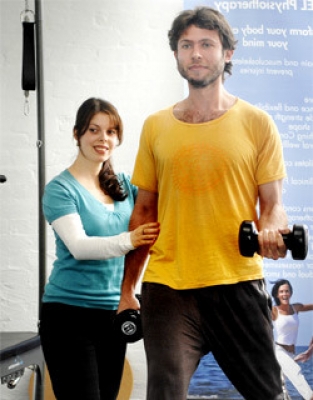Articles
Sports Injuries - The Elbow. Article by Margarita Gurevich, published in Great Health Guide

physiotherapist-Margarita-Gurevich
by Margarita Gurevich
Senior Physiotherapist
Tennis elbow and golfers elbow–unlike the names suggest, they do not affect only tennis and golf players. In fact, ‘tennis elbow’ and ‘golfers elbow’ are not accurate diagnoses and the correct terms are lateral and medial epicondylitis respectively, which mean inflammation of the lateral (outside) or medial (inner) epicondyles of the elbow.
In this article we will discuss the common causes, symptoms and most importantly, what can be done to treat these conditions.
What are the causes?
Lateral and medial epicondylitis can be caused by a lot of different factors, some of the more common ones being:
· The result of certain sports, such as tennis, badminton, weightlifting and others
· Repetitive tasks involved in certain occupations, most commonly computer work
Certain sports & repetitive tasks cause elbow inflammation.
What are the symptoms?
Symptoms commonly involve pain, tenderness and often swelling around the elbow and forearm, particularly when gripping and lifting. This can involve even light items such as the kettle. You might also experience pain and discomfort when straightening and bending the elbow.
What are the treatment options?
So what can you do if you have lateral or medial epicondylitis? The good news is that with the right approach these conditions can usually be effectively treated. In most cases both respond really well to physiotherapy treatment. From our experience the following have been shown to be very effective:
1. Electrotherapy treatment:
Ultrasound, drug phoresis (delivery of anti-inflammatory medications, such as Voltaren Emulgel, through ultrasound), interferential and SCENAR therapy help to resolve pain and inflammation, speeding up the recovery process.
You should generally start to feel better after approximately three sessions – if you don’t, your physiotherapist will most likely refer you for further tests to make sure that the diagnosis is correct. Ultrasound is the most common diagnostic test.
2. Soft tissue work:
Soft tissue massage can often be quite effective in reducing tightness of the forearm muscles, which occurs as a result of lateral and medial epicondylitis. While it’s normal to experience some discomfort during the massage, the pain should never be sharp. If you feel that the pressure is too hard make sure that you communicate this to your physiotherapist.
3. Specific exercise program:
Once the pain and inflammation are under control it’s important to start stretching and strengthening exercises. In fact, some exercises should be commenced straight away, even before your symptoms are under control. These include postural and shoulder exercises. As your condition improves exercises that directly target the elbow and wrist will be incorporated into your program.
Good posture & adequate strength in your whole arm is vital.
The reason why postural and shoulder exercises are important is that unless you have good posture and adequate strength in your whole arm, not just in the elbow and wrist, your chance of future recurrences will be higher.
Please note that the above information is not a substitute for seeing a trained health professional. Each case is individual and it is therefore important to be thoroughly assessed first. Following the assessment, the right treatment approach will be prescribed for you.
